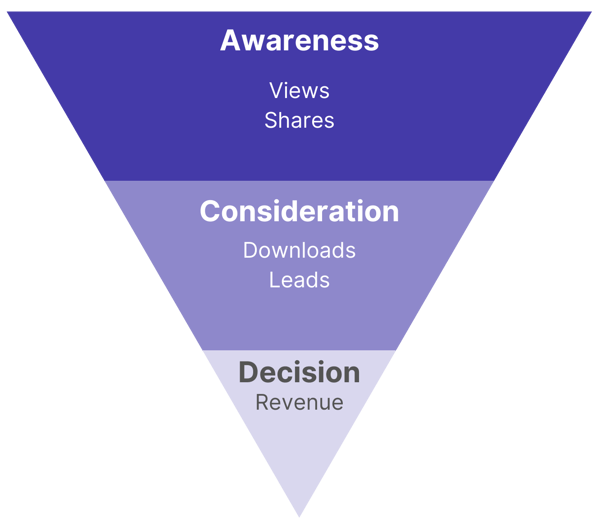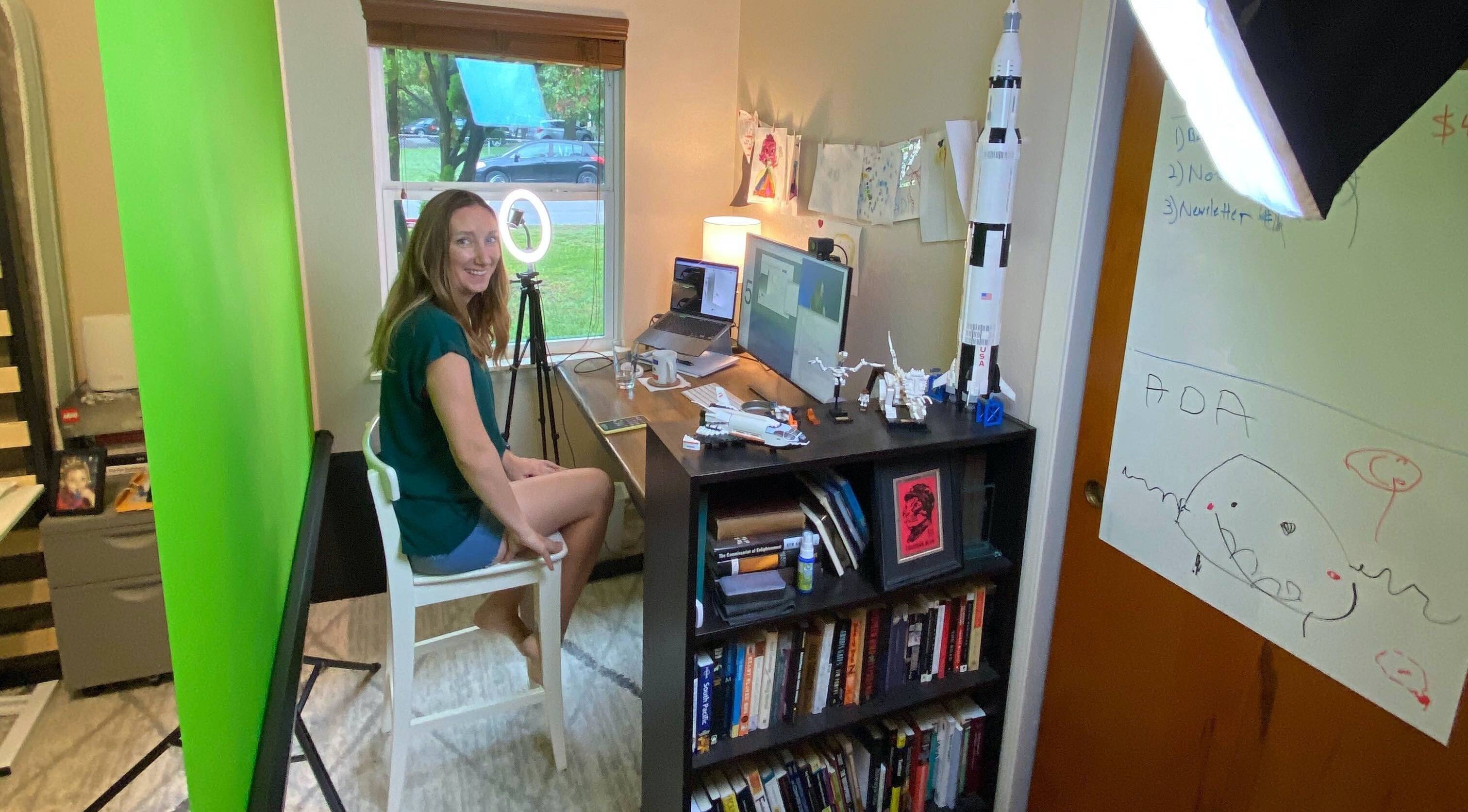You work hard to produce great content, so your content should work harder to produce great sales outcomes.
That means that your content marketing efforts must be more closely connected to your sales data. Let's talk about how to do that.
The most effective content marketers are part creative and part data-driven. They are brilliant writers who know how to shape their ideas through audience analysis. They know they don't create in a vacuum, and that their work is most impactful when it's based in reality, informed by data to help them shape their strategy moving forward. Content marketing is art and science.
Know your content types
Content marketing works best when it's built on a diverse catalogue of content distributed across multiple channels over time. That means producing content in different weights and formats - large seminal pieces, along with smaller, quickly digestible pieces. I'll explain.
Content pillars are the main piece of content you're promoting for a campaign. A pillar is usually a significant deliverable - like a webinar, ebook or whitepaper, research report. It takes longer to produce and is probably highly polished. It's something a prospect would consider valuable enough to give up their email address for.
Content exhaust is all the bits leftover from a content pillar deliverable. That includes clips, highlights, outtakes, screenshots and images, quotes, and so on. It’s the snackable byproduct of a piece of content. Content exhaust is perfect for social media and other promotion, to direct audiences to the central content pillar.
Content cuttings are the remixes you can create from a piece of content later. That includes new formats, repackaged or revisited pieces, sequels, etc... Content cuttings are the children of another piece of content that find new audiences sometime down the road.
Let’s say you write a blog post. That post is your central content pillar, and it includes the main messaging for a campaign. It probably goes into detail about your topic, includes some images, and is generally a pretty robust piece of content.
Your content exhaust could be an excerpt, a quote that didn’t make it into the final version, a diagram or GIF from the post, a short bulleted list of the main points, and so on. Small pieces from the post that you can sprinkle around to drive interest in and back to the post itself.
Your content cuttings could be a follow-up webinar based on the post’s concepts, a video explaining an example from the post in more detail, a PDF checklist based on the post, a downloadable kit that includes the original post and a few other pieces from your archive. Cuttings take more work than exhaust to produce, but they turn into full-length pieces on their own that you can run entire campaigns around. Since you’ve already written the blog post and fleshed out the main ideas, cuttings are quicker to put together than the original pillar piece was, but can get just as much - if not more - life than the parent.
If you’ve got a piece of content that’s driving results, you should be making cuttings from that content. Otherwise you’re leaving money on the table. So how do you know if your content is driving results?
Know how your content performs
How do you measure the performance of a piece of content? I could write an entire post on content measurement, but briefly, it should depend where in the funnel you’re targeting. When you create a piece of content, you should have a target audience and related KPIs in mind.
Where in the buyer journey is the audience for this content? This requires close alignment between sales and marketing, which is the only way you're really going to have true content marketing success. You'll need more than the marketing reporting you get from your CMS or automation software. Start here:
- Awareness stage: Measure views, shares, subscribers
- Consideration stage: Measure downloads, leads (or opps or demo sets)
- Decision stage: Measure C/W revenue

Beyond these foundational metrics, there’s a lot you can learn from the rest of your sales data. Dig into metrics like the following to understand the larger context of your content.
- Demos held. How many demos do we hold compared to how many were requested or set?
- Opportunity age. How long does it take to close a deal?
- Close rate. How many deals do we close?
- Retention. What percentage of accounts or revenue do we retain at renewal?
- LTV. How much is a customer worth over their lifetime with us?
Do the opportunities associated with this piece of content look different than the typical opportunity in your company's sales pipeline? What can you learn from that data? Fundamentally you want to know what content generates the right leads.
Know your audience
We typically associate content marketing with the awareness stage of the funnel. If you write good content, the audience will come.
But that’s a gross oversimplification of the impact an effective content marketing strategy can have on a company’s full sales funnel. There’s content for every buyer at every stage in their journey. It’s up to the content marketer to plan it, create it, and distribute it, so the customer gets what they need when they need it.
Content targeted to the awareness stage of your funnel should be engaging and informative. It should focus on industry trends and topics of general interest to your audience. It can mention your product, but shouldn’t be product-focused. This is where your thought leadership has a time to shine. Find a unique angle on a topic your ideal buyer is interested in. Awareness content is meant to attract potential buyers, and begin to establish your credibility with that audience.
When buyers are in the consideration phase - they’ve requested or received a demo, for example - you should be providing more concrete product content. Case studies are ideal for this stage. Demonstrate a compelling case for why someone should purchase your product, which is especially effective if you can show how someone similar to your potential customer succeeded with your product. What does it do? How has it helped someone else? You need quantifiable results and a good story.
Finally, when a buyer is in the decision stage, they’re ready for how-to content. How to achieve those incredible results you promised them earlier. Think about useful onboarding videos, illustrative use cases and case studies, clean and simple documentation that makes it clear what they need to do to get started.
Know when to double down
When you hit on something that’s working, you should lean into it. For example, if you created an ebook that’s been downloaded a few thousand times, contributed to 50 demo sets, and 3 closed deals totaling more than $30k in revenue, you should probably do more with that ebook, right?
Of course. But don’t just keep promoting that exact same piece of content. Find ways to propagate cuttings of that ebook across the internet, targeted to different stages in your buyer’s journey. Package it up with some other content you’ve produced in a downloadable “everything you need to get started with X” kit. Pitch a byline for an industry publication that goes deeper into one of the more salient points in the ebook. Write a blog post highlighting the five key takeaways from the ebook. Record a podcast interview with an expert on the topic. Create an infographic. Write a case study. Create a how-to video.
What if you have an ebook that’s been downloaded many times, but not resulting in the down-funnel success you’d expect? Take a closer look at what’s happening after that download. The two most likely scenarios for high awareness but low conversion are a) you’ve reached the wrong audience, or b) your inbound reps aren’t prepared to talk about the content.
If you’ve created a popular piece of content attracting a large audience, but that audience doesn't need your product, then you’re wasting your time.
At Union Metrics, we knew that any time we published something about Instagram marketing, it would go gangbusters. Those were by far our biggest webinars and most downloaded ebooks. But most of the people consuming that content were individual influencers or small companies just getting started - and they weren’t in the market for an enterprise social analytics solution. Good content, but wrong for us.
At Cision, our most successful content launches involved a thorough internal sales rollout. We’d prep our inbound and sales teams with a deck about the new content, talking points for prospects, connections back to the product, and so on. You can’t expect a BDR to follow up on a new inbound lead if they don’t know what the whitepaper someone downloaded was about and how it fits into our larger GTM motions. Good content needs good support. (For more on how to equip sales teams with content, read this.)
Good content is worth the investment
The best content marketers are closely connected to their colleagues in sales. They know how content contributes to the sales pipeline, and they know who their audience is and what they're looking for at every stage of their journey. Armed with that information, content marketers can produce and distribute content that generates real quantifiable value for an organization. Put another way, if you don't fully understand your company's buyer journey, you can't produce work that's worth investing in.
Want more content for sales and marketing? Sign up for our newsletter, which we pack full of ideas like this (and even better ones, from experts). Subscribe here.




